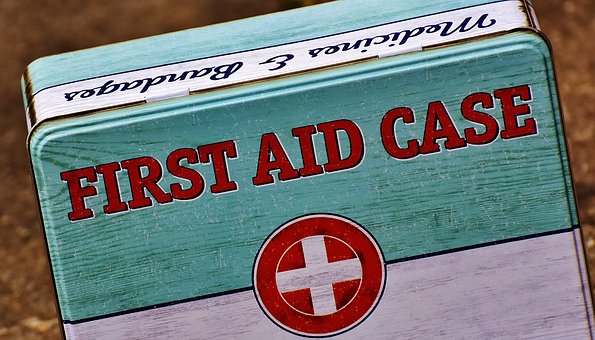Safety Plans and Mental Health

We always prepare a first aid kit for our physical injuries when we go on a camping trip. What if those of us who have experienced symptoms of mental illness had a way to prepare a first aid kit or safety plan to meet those needs?
There are many different types of safety plans but one for my depression and anxiety was the one I never imagined I would need and I wish was explained to me. The plan I probably put the most thought into was the birth plan for my first child. Specifics such as what music to have on, what to have as a focus object, not to have drugs if possible were thought about and discussed with both my husband and my doctor. I will say, the plan was mostly followed although, I did take a little something for the pain.
The other type of plan that comes to mind is a fire safety plan for your house and family members. What do you do if the fire comes near you? What are the alternate ways out of the house: windows, doors? And where to meet up once you are out?
Safety Plans and Mental Health
In January 2010, when I spent time in a Mood Disorder Unit at my local hospital, I became very familiar with what a safety plan is and would not be leaving the hospital without a fully prepared one for myself. I realize that I was not presenting my true feelings to all of those around me during the time prior to my hospitalization. However, I don’t specifically recall being asked about suicidal ideation and I certainly don’t remember being asked or talked to about a safety plan.
I like the idea of having a preventative approach to a mental health crisis. This plan would be set up, perhaps with help of a therapist, while not in the throes of a crisis. A safety plan like this could extend to many different types of conditions, including suicidal ideation, non-lethal self-harm, eating disorders, and other conditions where having specific steps or distractions would be in order.
A problem with this whole idea is that until one reaches rock bottom or makes an attempt, there is so much secrecy and shame around not wanting to tell “your truth”. Part of the challenge, as those who experience mental illness know, is to discover our truth, own our truth, and to share our truth. When you are developing a safety plan of strategies to keep your worst-case scenario at bay, it is important to be honest about what things you will actually do if the time comes.
 Creating a Crisis Plan or Safety Plan
Creating a Crisis Plan or Safety Plan
People can still experience a crisis when they have utilized the best resources available. It is important to have a written plan in place in case of a crisis. A good plan will:
- Identify people willing to help
- List the phone numbers of the mental health providers and the mental health crisis team
- Include a list of current medications and their dosages
- List treatments that have been used in the past (CBT, DBT, etc.)
- Identify key words or calming techniques that have worked in the past
- Identify your loved one’s preferred treatment facilities
- Include a copy of their advanced psychiatric directive (if available)
Source: NAMI
Create a written plan of action or a “safety plan” with your mental health provider that you can refer to when you’re considering suicide or in a crisis. Learn to spot your warning signs early, so you can put your plan into action.
For suicidal ideation, The Mayo Clinic website suggests:
“Your plan is a checklist of activities and actions you promise to do, so you can stay safe when you have thoughts of suicide, such as:
- Contact your doctor, therapist or crisis center to help you cope with suicidal thoughts
- Call a supportive family member or friend who can help you cope with your suicidal thoughts
- Try specific healthy and enjoyable activities when negative thoughts start to intrude
- Review why your life is valuable and the reasons to live.”
Here is a sample plan for your reference: Create a Safety Plan.
Other Safety Plans
Many mental health conditions do not always include suicidal ideation; however, putting a crisis plan together can be an extremely helpful preventative measure. For example, when I was a teenager and I was experiencing undiagnosed anxiety and depression, I was participating in a form of self-harm. I was a cutter, using my own fingernails to pinch until I bled. I was good at hiding this in places my clothes would cover. I eventually stopped this behavior until the crisis that I experienced in the 2009-2011 time-frame, in which I had a period of hospitalization. I began to find myself repeating those earlier behaviors. I needed to create a safety plan in order to distract and soothe myself in non-harmful ways.
Non-lethal Self-Harm Safety Plans
Find new coping techniques
- If you self-harm to express pain and intense emotions, paint, draw or scribble on a big piece of paper with red ink or paint.
- To calm and soothe yourself, take a bath or hot shower.
- If you feel disconnected and numb, interact with a loved one, either in person or over the phone.
- To release tension or vent anger, perform intense exercise.
I believe that writing things down helps in cementing a plan or idea. This list of questions can help to create a safety plan around avoiding triggers and using distractions to help with the feelings leading to wanting to self-harm.
- What was going on in my life when I first began to injure myself?
- How do I feel just before I want to injure myself?
- What are my habits and routines? Am I always in the same place or with a particular person when I get the urge to injure myself?
- Do I always feel the same emotion when I get the urge to injure myself?
- How can I better deal with the situations that trigger me?
Safety Plans for Eating Disorders
It is critical to learn healthier ways to cope with uncomfortable feelings. One website notes, “It may seem like eating disorders are all about food—after all, your rules and fears about dieting and weight have taken over your life. But food, itself, isn’t the problem. Disordered eating is a coping mechanism—whether you refuse food to feel in control, binge for comfort, or purge to punish yourself. But you can learn healthier ways to cope with negative emotions.”
“It is also important to understand the emotional need your eating disorder fills. The first step is figuring out what’s really going on inside. Are you upset about something? Depressed? Stressed out? Lonely? Is there an intense feeling you’re trying to avoid? Are you eating to calm down, comfort yourself, or to relieve boredom? Once you identify the emotion you’re experiencing, you can choose a positive alternative to starving or stuffing yourself.”
Here are a few suggestions to get you started:
- Call a friend
- Listen to music
- Play with a pet
- Read a good book
- Take a walk
- Write in a journal
- Go to the movies
- Get out into nature
- Play a favorite game
- Do something helpful for someone else
Source: https://www.helpguide.org/articles/eating-disorders/eating-disorder-treatment-and-recovery.htm
Coping with anorexia and bulimia: Emotional Do’s and Don’ts
Do
- allow yourself to be vulnerable with people you trust
- fully experience every emotion
- be open and accepting of all your emotions
- use people to comfort you when you feel bad, instead of focusing on food
- let your emotions come and go as they please without fear
Don’t
- pretend you don’t feel anything when you do
- let people shame or humiliate you for having or expressing feelings
- avoid feelings because they make you uncomfortable
- worry about your feelings making you fall apart
- focus on food when you’re experiencing a painful emotion
More than seven years be passed since my hospitalization for severe depression with suicidal ideation. In my desk lay several pages of paper that are barely holding their form from being handled so much as I created my safety plans and subsequent times referring to the plan as I recovered. As I stated at the beginning of this piece, I believe there is much benefit to at least thinking about creating a plan even if it’s not written down. Doctors and therapists can help by downplaying the stigma attached to admitting to mental health concerns.
An ounce of prevention is worth a pound of cure.
RESOURCES:
- Challenge the Storm’s Resources page
- National Suicide Prevention Lifeline (Crisis Hotline)
- 1-800-273-TALK (8255)
- 1-800-799-4TTY (4889) TTY
- American Foundation for Suicide Prevention (AFSP)
- National Institute for Mental Health Suicide Prevention
- Suicide Prevention Resource Center
- VA Suicide Prevention
- Department of Defense Suicide Prevention
- American Association of Suicidology
- International Association for Suicide Prevention (IASP)
- CSSRS Website

 Creating a Crisis Plan or Safety Plan
Creating a Crisis Plan or Safety Plan











